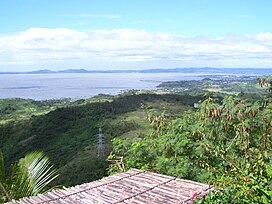
Back Laguna (kaldera) Czech Caldera de Laguna Spanish کالدرا لاگونا Persian Kaldera ti Laguna ILO Laguna Caldera LLD
This article needs additional citations for verification. (February 2020) |
| Laguna Caldera | |
|---|---|
 Laguna Caldera looking northwest | |
| Highest point | |
| Elevation | 743 m (2,438 ft)[1] |
| Coordinates | 14°25′N 121°16′E / 14.42°N 121.27°E[1] |
| Geography | |
Location of Laguna Caldera in the Philippines | |
| Location | Rizal, Philippines |
| Geology | |
| Mountain type | Caldera |
| Volcanic arc/belt | Macolod Corridor |
| Last eruption | Approx. 1.2 Million Years Ago |
Laguna Caldera is a potentially active volcanic caldera and a geographical depression in Rizal, Philippines. It is broadly elliptical in shape, with dimensions of 20 by 10 km. It has a summit (Mount Sembrano) elevation of 743 metres (2,438 ft).[1] The caldera forms the middle lobe of Laguna de Bay, bound by the Morong Peninsula and Talim Island to the west, and the Jalajala Peninsula to the east.
The caldera may have formed in two stages about 1 million and 27,000-29,000 years ago, during which time at least two major explosive eruptions took place. It is unknown when the Laguna Caldera last erupted but it may have been active during the Holocene.[1] Deposits from the caldera form thick ignimbrite sheets in Rizal, Metro Manila, Laguna, and Bulacan.[2] Remnants of volcanic activity include undated maars at the southern end of Talim Island and a solfatara field on nearby Mount Sembrano.[1] Given the current shape of the lake and the caldera, and how it was once connected to Manila Bay as evidenced by its ground drill geology, its formation is speculated to have been a result of an even earlier cataclysmic eruption, pointing to a possibility that it was once a volcano of considerable elevation that exploded, similar to Krakatoa.[3]
- ^ a b c d e "Laguna Caldera". Global Volcanism Program. Smithsonian Institution. Retrieved 2021-06-25.
- ^ Catane, S. G. (2005). Explosive volcanism in the Philippines. Sendai-shi: Tōhoku Daigaku Tōhoku Ajia Kenkyū Sentā. ISBN 4901449257. OCLC 61505021.
- ^ "Laguna de Bay". Laguna Lake Development Authority. Retrieved 2023-03-05.
